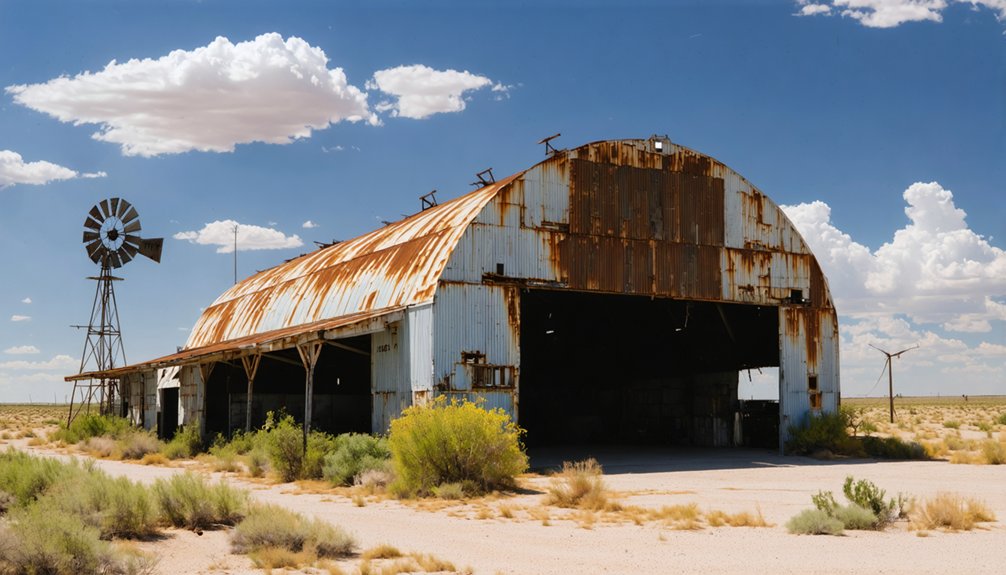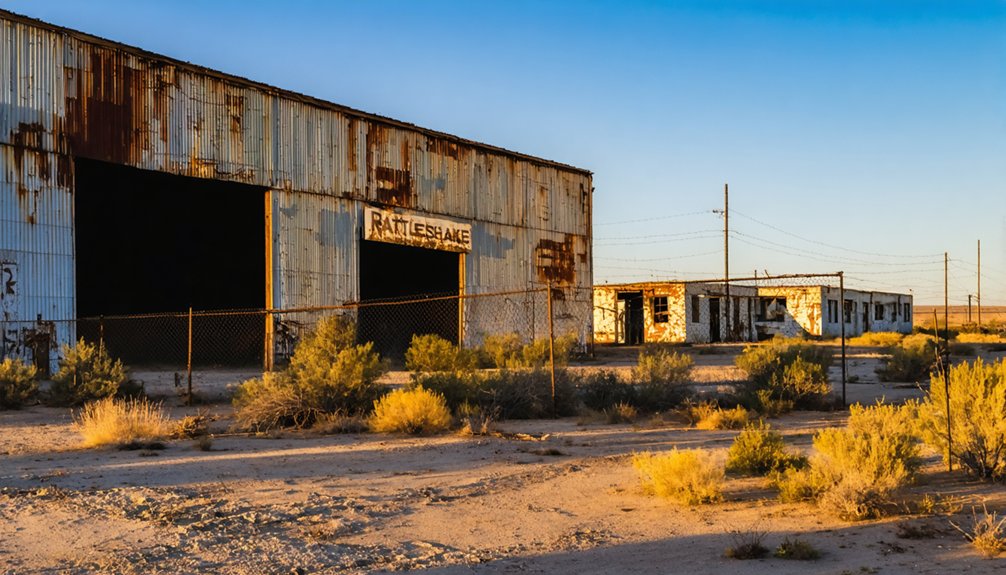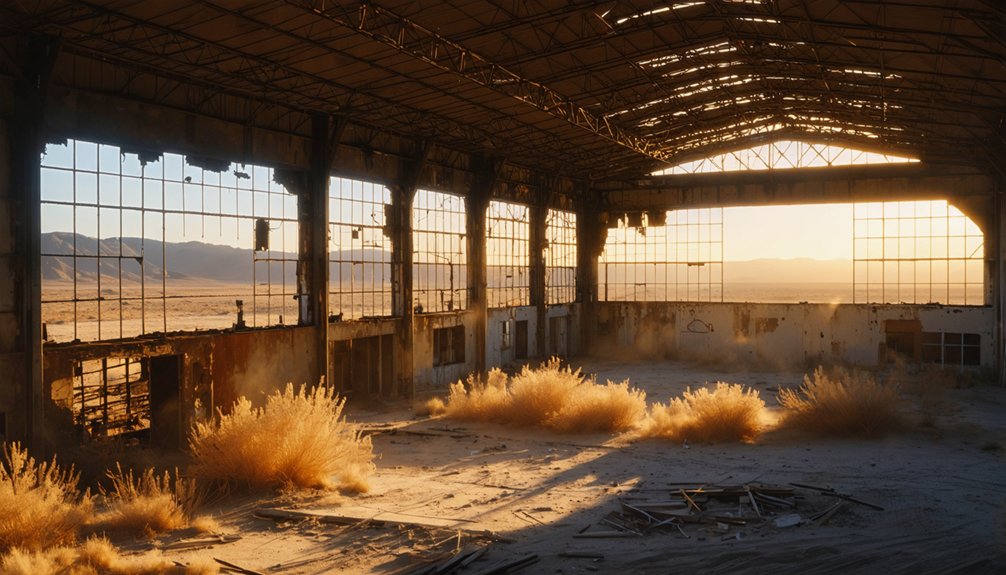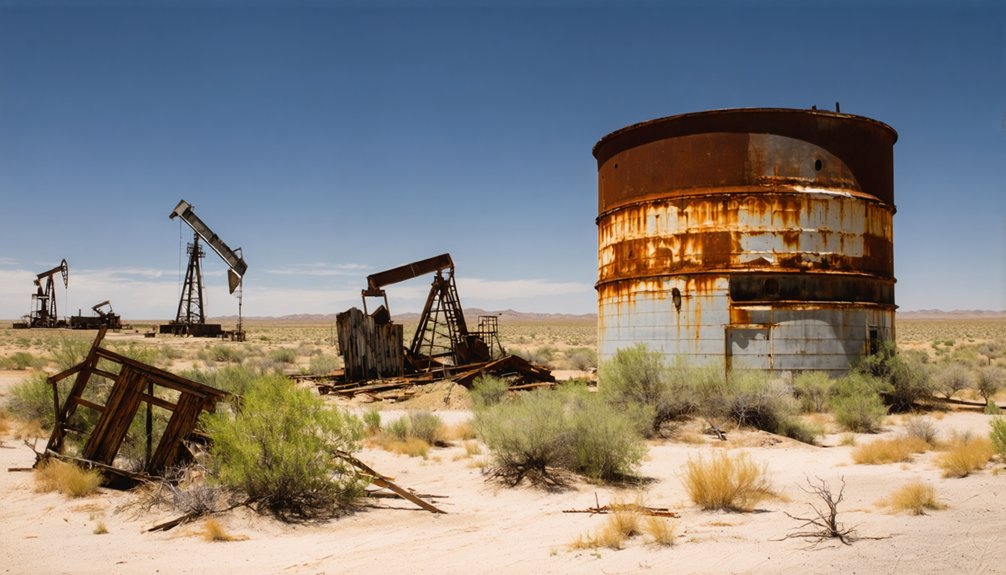You’ll find Pyote tucked away in the stark West Texas desert, where rattlesnakes once ruled before bombers took to the skies. This former boomtown grew from a dusty railroad stop into America’s largest WWII bomber training base, housing 10,000 folks at its peak. Now, the wind whistles through rusted hangars and empty streets where fewer than 100 souls remain. The crumbling concrete and desert sands hold stories of war heroes, troubled youth, and frontier dreams.
Key Takeaways
- Once home to 10,000 residents during WWII, Pyote has declined to fewer than 100 people today, qualifying it as a ghost town.
- The abandoned Rattlesnake Bomber Base, which was America’s largest bomber installation, stands as a decaying reminder of Pyote’s military past.
- The town’s dramatic population decline followed the 1963 closure of the Air Force base, marking the end of its economic prosperity.
- Most original WWII-era buildings and infrastructure remain but are deteriorating, including massive hangars and dual 8,400-foot runways.
- Former military buildings were converted into a children’s home and later a juvenile detention facility, but many structures remain abandoned.
From Coyotes to Chinese Railroad Workers: The Birth of Pyote
Before the Texas and Pacific Railway carved its way through West Texas in 1881, Pyote was little more than a stretch of sun-baked earth where coyotes roamed free and Native American tribes followed ancient paths across the desert.
The wild coyote‘s presence shaped local lore, becoming a powerful symbol of the untamed frontier that early settlers would soon challenge. A telegraph office first brought modern communication to this remote area in 1881.
When Chinese railroad workers arrived to lay tracks through this harsh terrain, they faced scorching heat and backbreaking work. Their determination helped forge the iron pathway that would transform this remote outpost. The town’s first signs of permanent settlement emerged when a post office opened in 1907.
The Rise of the Rattlesnake Bomber Base
You wouldn’t believe how fast those mesquite-covered flats transformed into one of the biggest bomber training grounds in Texas when the Army Air Forces broke ground in September 1942.
Construction crews faced a unique challenge as they had to clear out numerous rattlesnake dens before building could begin.
What started as rattler country quickly swelled to a bustling military city of 6,500 folks by ’44, with massive hangars and dual runways stretching 8,400 feet across the West Texas desert.
Soldiers and airmen trained at the Pecos Trail Region base day and night, preparing for the challenges ahead.
Those twin strips of concrete turned Pyote into a powerhouse, sending crews of B-17 Flying Fortresses and B-29 Superfortresses into the wild blue yonder for combat missions overseas.
Strategic Military Location Chosen
When the U.S. military needed a prime spot for bomber training during World War II, they couldn’t have picked better than Pyote’s sprawling West Texas terrain.
The military strategy behind choosing this patch of desert was as clear as a West Texas morning – you’d be hard-pressed to find terrain more suitable for those long bomber runways. Within just four months of opening, it had become the largest bomber installation in the entire country.
The geographic advantages stacked up mighty fine: U.S. Highway 80 ran right by it, making it easy to move supplies and personnel. Construction began swiftly in September 1942 to meet wartime demands.
Year-round blue skies meant perfect flying weather, and being smack in the middle of oil country didn’t hurt none either.
Best of all, this remote stretch of land kept operations safer than a rattler in its den, far from prying eyes and potential threats.
You might say Pyote was just what Uncle Sam ordered.
Personnel and Aircraft Growth
Once the Army Air Corps set their sights on Pyote, things started hoppin’ faster than a tumbleweed in a dust storm.
By September ’42, bulldozers were kickin’ up dust, carvin’ out two mighty fine 8,400-foot runways in a triangle formation that’d make any pilot proud.
Y’all wouldn’t believe how this place grew like a jackrabbit. From empty desert to a bustlin’ military town, the base swelled to house more than 6,000 servicemen by ’44.
They weren’t just sittin’ pretty either – crews were training round the clock on B-17s, and later them big B-29 Superfortresses. The base earned its nickname “Rattlesnake Bomber Base” due to its remote west Texas location.
Five massive hangars sprouted up to keep them birds in tip-top shape. The base became such a sight that even Walt Disney’s folks designed their official insignia, puttin’ Pyote on the map proper. The Pearl Harbor attack in 1941 had rallied local citizens to propose this vital training facility.
Training Ground for World War II Heroes
Deep in the heart of West Texas, Pyote Army Airfield sprawled across nearly 2,800 acres of rattlesnake-infested desert, earning its nickname “Rattlesnake Bomber Base.”
This significant World War II training facility transformed raw recruits into skilled bomber crews, initially mastering the B-17 Flying Fortress before switching to the mighty B-29 Superfortress.
Y’all might reckon it wasn’t easy out there in that desolate stretch of Texas hardpan, with five hangars and two 8,400-foot runways carved right into rattler country. The base included over 300 buildings that supported the massive training operation.
But those airmen didn’t back down from the wartime challenges. Distinguished units like the 19th, 381st, and 96th Bombardment Groups cut their teeth here, and by ’45, they were setting records for bomber crew training hours. Within just four months of opening, the base became the largest bomber installation in America.
Despite the isolation and sparse amenities, Pyote’s crews were ready when Uncle Sam called.
Peak Years: When 10,000 Called Pyote Home
Back when World War II kicked into high gear, you’d have seen Pyote transform from a sleepy West Texas town into a bustling military community of 10,000 souls.
Uncle Sam’s mighty air base brought waves of servicemen and their families, who filled up newly-built housing developments faster than tumbleweeds roll across the desert.
Local shops and businesses sprouted up like spring wildflowers to serve all these newcomers, turning Pyote into a proper boomtown with a thriving wartime economy.
Military Families Move In
During World War II, Pyote transformed from a sleepy West Texas outpost into a bustling military town as thousands of service members and their families poured in from across the nation.
The military integration brought dramatic changes as housing developments sprung up faster than tumbleweeds, while new schools and shops popped up to serve the influx of folks.
Family dynamics shifted as young couples with kids settled into base life, creating tight-knit bonds in this desert community.
- You’d see military wives gathering at the commissary, sharing news and supporting each other
- Children’s laughter echoed through base housing as kids played freely in the streets
- Weekend barbecues and social clubs brought families together under the big Texas sky
- Local businesses thrived as military paychecks kept the town’s economy humming
- Churches and schools filled with new faces, breathing life into Pyote’s community spirit
Booming Wartime Economy Emerges
When Uncle Sam came calling in ’42, Pyote transformed from a dusty West Texas crossroads into a powerhouse of wartime industry. You’d hardly recognize the place as thousands of troops and civilian workers poured in, swelling the population to over 6,500 by ’44.
Those five massive hangars sprouting up along Highway 80 weren’t just for show – they made Pyote the biggest bomber installation in the whole United States.
The population dynamics shifted faster than a West Texas dust devil as folks rushed in to grab their piece of the economic pie. Machine shops, warehouses, and businesses of all stripes cropped up to serve the booming military presence.
From aircraft maintenance to supply chains, everyone with willing hands found work in this desert boomtown.
Base Housing Expands Rapidly
As troops kept rolling into Pyote by the trainload, you’d see new housing units springing up faster than tumbleweeds in a March wind.
Housing development transformed this once-quiet West Texas outpost into a bustling military town, complete with modern community amenities that’d make any big city folk feel right at home.
- Your neighbors weren’t just faces anymore – they were families sharing victory gardens and weekend barbecues.
- You’d find kids playing stick ball in the streets while mommas chatted on front porches.
- Base exchanges and commissaries meant you didn’t have to drive clear to Monahans for supplies.
- Churches and schools popped up like prairie flowers after a spring rain.
- Every new house meant another family making Pyote their slice of the American dream.
The Enola Gay’s Desert Rest Stop
Before heading to its final roost at the Smithsonian’s Udvar-Hazy Center, Colonel Tibbets’ aircraft shared the sprawling desert facility with thousands of other retired warbirds.
While most planes met their fate in the scrapyard, the *Enola Gay* survived its West Texas sojourn to become a powerful reminder of aviation history.
From Military Might to Silent Runways

If you’d stood in Pyote during its wartime heyday, you’d have seen 6,500 military folks bustling around this West Texas outpost, training crews for the Army Air Force’s mighty bombers.
These days, you won’t hear the roar of B-17s or spot airmen dodging rattlesnakes on their way to the mess hall – just the whisper of desert winds across abandoned runways.
The base that once hummed with activity now rests silent as a sun-bleached bone, its crumbling hangars telling tales of America’s World War II might.
Wartime Population Explosion
The sleepy West Texas town of Pyote transformed overnight when Uncle Sam picked its dusty patch of desert for a massive bomber training base in 1942.
The wartime migration brought over 6,000 military personnel and hundreds of civilian workers, turning this modest settlement of 201 souls into a bustling wartime hub.
Y’all wouldn’t believe how that little oil-bust town found new life as dollars started flowing through local businesses.
- Base personnel outnumbered locals by 30-to-1 at peak strength
- Rattlesnakes scattered as concrete runways stretched across the desert
- Local merchants traded quiet days for round-the-clock commerce
- Makeshift housing sprouted faster than tumbleweeds
- Downtown Pyote’s 15 businesses couldn’t keep up with military paychecks
The economic impact rippled through Ward County like a summer thunderstorm, bringing prosperity to a corner of Texas that needed it most.
Deserted Base Tells Tales
Once bustling with thousands of airmen and hundreds of warbirds, Pyote Air Force Base now stands silent as a sun-bleached skeleton in the West Texas desert.
If you’re fixin’ to explore these parts, you’ll find only a lone hangar and crumbling runways where the mighty Enola Gay once rested her wings.
The old-timers’ll tell you ghost stories about the abandoned structures, where rattlesnakes now outnumber people.
Those 1.5-mile runways that launched freedom-defending bombers are slowly being reclaimed by the harsh desert. You can almost hear the phantom roar of B-29s and B-17s echoing across the empty base.
While most evidence of this former military powerhouse has vanished into the Texas wind, the Million Barrel Museum in nearby Monahans keeps the base’s legacy alive.
The Children’s Home and Juvenile Detention Era
Following the old air base’s closure in 1963, Pyote’s empty military buildings found new life as the West Texas Children’s Home in 1966.
Y’all mightn’t know it, but those old Air Force quarters and radar buildings transformed into a haven for orphaned youngsters, thanks to $200,000 from the Texas legislature.
By the 1980s, though, the winds of change swept through, turning it into a juvenile detention facility called West Texas State School.
Time marched on and the children’s home transformed, becoming a place where troubled youth faced their demons behind secure walls.
- Empty dormitories now stand where troubled boys once sought redemption
- Faded chalk marks still linger on classroom walls where kids studied for their GEDs
- Chain-link fences whisper tales of both hope and heartache
- Weathered basketball courts remind us of dreams that soared and fell
Out here in the desert, these buildings hold secrets of young lives changed forever.
Preserving the Past: The Bomber Base Museum

Deep in the heart of West Texas, where rattlesnakes once shared runways with mighty bombers, you’ll find the Rattlesnake Bomber Base Museum tucked away in the old mess hall of Pyote’s Community Center.
Since 1978, this treasure trove of military memorabilia has been keeping the spirit of World War II aviation alive. Y’all can mosey through displays of shoulder sleeve insignia, medals, and uniforms while learning about local heroes like Lt. John Jamison and Sgt. Carl Anderson.
The museum’s pride and joy is its Norden Bombsight exhibit, a piece of equipment that changed the course of the war.
For historical preservation buffs, the museum’s free admission and by-appointment tours at the Million Barrel Museum complex make it worth the drive down those long Texas highways.
Life in Modern-Day Pyote
While many Texas towns have grown into sprawling cities, modern-day Pyote remains a tiny slice of West Texas life, with fewer than 100 folks calling it home.
You’ll find mostly middle-aged residents and families weathering both economic struggles and community challenges together. Despite the town’s small size, folks here maintain their independence with a mix of jobs in construction, mining, and local services.
- Y’all can buy a home for about $175,000, well below big city prices
- Most neighbors here have known each other for decades
- Local kids grow up with plenty of wide-open Texas sky
- Nearly everyone owns their own piece of land
- The community sticks together through thick and thin, even with 30% of families facing tough times
The Legacy of a West Texas Military Town

Out in the heart of West Texas oil country, Pyote transformed from a dusty railroad stop into one of America’s mightiest bomber training bases during World War II.
You can still feel the military culture that once defined this stretch of desert, where the “Rattlesnake Bomber Base” trained thousands of airmen for the Pacific Theater.
The historical significance of Pyote runs deeper than its wartime role. After hosting up to 8,000 souls at its peak, the base became home to legendary aircraft like the Enola Gay.
When the Cold War came calling, Pyote answered again as a radar station. Though the bustling military town has faded into a ghost town, its legacy lives on through the museum that preserves stories of those who shaped America’s air power in these remote Texas plains.
Frequently Asked Questions
What Happened to the Chinese Railroad Workers After Pyote’s Founding?
You’ll find most Chinese railroad workers left after their contributions ended, though some stayed in El Paso County, where they switched to running businesses and working farms by 1890.
How Many Rattlesnakes Were Actually Found During the Base’s Construction?
Truth’s as slippery as a snake’s belly – you’ll never know exactly how many rattlers they cleared, but construction hazards and daily rattlesnake encounters suggest hundreds were found during base buildup.
Did Any Famous Pilots Train at the Pyote Air Force Base?
Y’all might recognize Charlie Brown, who trained there with his B-17 crew before his famous “Higher Call” encounter. The 19th Bomb Group’s famous aviators ran training programs there too.
What Specific Kinds of Abuse Occurred at the West Texas State School?
As plain as day, you’re looking at institutional abuse that’ll turn your stomach – sexual assault by top staff, physical violence, and neglect scandals that rocked West Texas State School’s juvenile detention center.
Are There Any Restrictions on Visiting the Abandoned Base Structures Today?
You’ll find no official visiting regulations, but y’all need to watch for private property and stay mighty careful – those old structures ain’t stable. Use common sense safety precautions out there.
References
- https://picturesofthepast.com/abandoned/pyote/
- https://www.tshaonline.org/handbook/entries/pyote-tx
- https://www.co.ward.tx.us/page/ward.pyote.rattlesnakemuseum
- https://en.wikipedia.org/wiki/Pyote_Air_Force_Base
- https://www.ghosttowns.com/states/tx/pyote.html
- https://twodifferentgirls.com/2012/04/29/a-ghost-town-thats-not-quite-dead-crappy-places-to-be-from/
- https://www.texasescapes.com/WestTexasTowns/Pyote-Texas.htm
- https://americanindiancoc.org/native-american-tribes-the-indian-history-in-pyote-texas/
- https://en.wikipedia.org/wiki/List_of_ghost_towns_in_Texas
- https://beyond.nvexpeditions.com/texas/pyote.php



